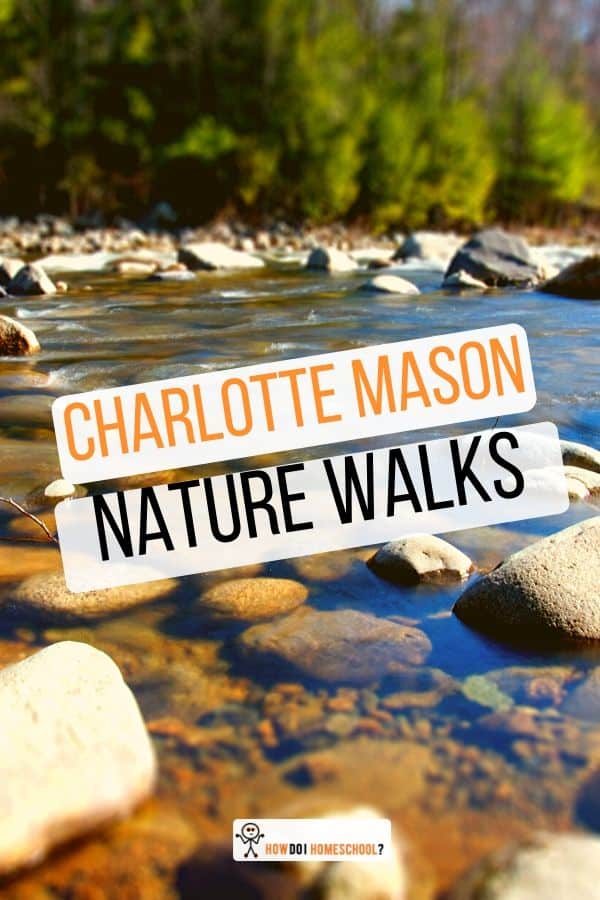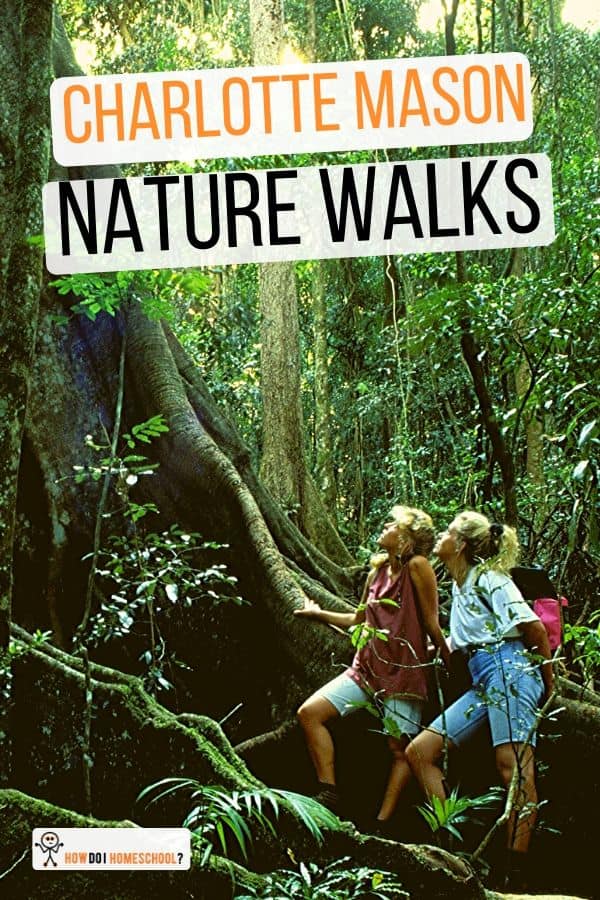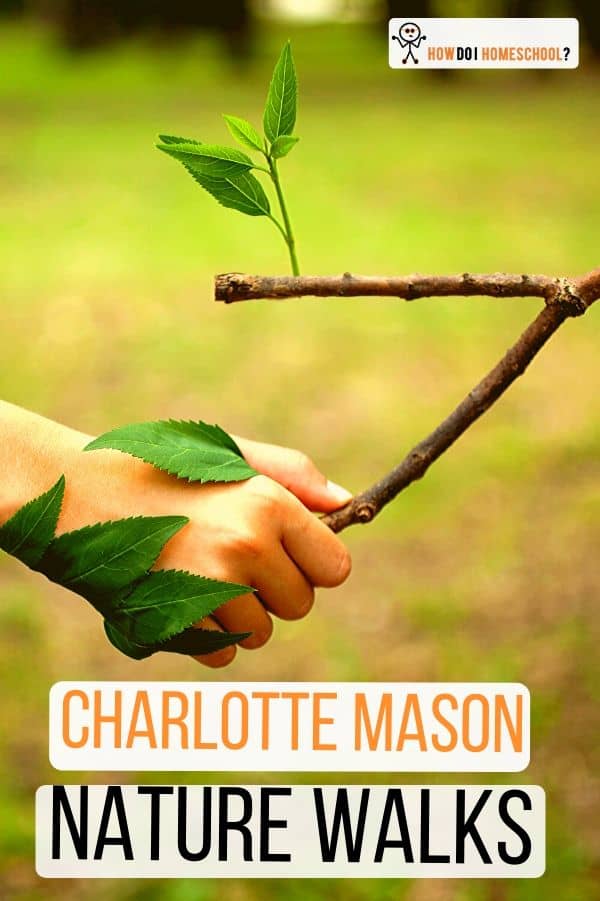Charlotte Mason nature walks are a great alternative to the iPad this summer. Parents can easily engage homeschoolers outdoors effectively by letting the flora and fauna be their teacher. A nature walk is a conscious consideration of one’s outdoor environment where children take down their observations and in a notebook, eventually building up their own encyclopedia of flora and fauna. Children start by taking their sketchpads and notebooks with them and then observe interesting phenomena which they record and then later research to add ‘fat’ to the bones of their observation.
A parent should always be present with children, quietly giving them additional information when they’re interest is piqued so they’ll remember and store the information away in their brains.

I hope you enjoy reading this blog post. If you want to do my course on how to homeschool, click here.
Let’s have a look at Charlotte Mason nature walks a little more closely below (or you can cheat by watching the video at the end of the article).

Why Do Nature Walks?
Why should we be bothered with nature walks in the first place? Why can’t we just encourage formal study indoors, and then send our children out unaccompanied for an hour or two of fresh air every day? Charlotte Mason gave a number of reasons why outdoor study is a good idea in her book ‘Home Education’, namely to:
- develop and build muscle mass by vigorous outdoor play
- train our senses to closely observe nature
- store up memories of a happy childhood
Mason explains it beautifully in the following paragraph:
For we are an overwrought generation, running to nerves as a cabbage runs to seed; and every hour spent in the open is a clear gain, tending to the increase of brainpower and bodily vigour, and to the lengthening of life itself. They who know what it is to have fevered skin and throbbing brain deliciously soothed by the cool touch of the air are inclined to make a new rule of life, “Never be within doors when you can rightly be without.”
Nature walks also give homeschoolers a good foundation for formal science lessons. Instead of studying butterflies in textbooks, children have the opportunity to observe them in nature. This increases their retention as the study is more interesting and because they have taken the information in as they were motivated to learn it.
Like adults, when children learn how amazing nature is, they can’t help but praise God for his great creation.
Generic Benefits of Walking in Nature
Other than the benefits above, there are many advantages of being outside and walking in nature that are commonly recognized for adults and children alike. Some of these are:
- reduced depression and anxiety
- improved immune system and memory
- reduced incidence of sickness and colds; and a better ability to overcome these sicknesses when you have them
- stops rumination (repetitive thoughts that focus on the negative aspects of self)
- better athletic performance and
- less mental illness
Because walking in nature has so many advantages, it is also commonly prescribed by Japanese doctors to improve mental health complaints.
How Much Time Should Be Spent in Nature Walks?
How long should nature walks take? In her book School Education, Mason recommended teachers take pupils out one afternoon a week for a nature walk. One of the many advantages of homeschooling is that parents have plenty of time to devote to outdoor learning activities.
Mason was a big believer in children spending the majority of their waking hours outside. For city dwellers, Mason recommended mothers should take a trip to the country in order to secure their children quiet growing time in nature. However, she admits this is what is best for children, although not necessarily practicable.



How to do a Charlotte Mason Nature Walk
When you do a nature walk, make sure you accompany your children as there will be lots of things to do (and lots of things to prevent) and observe.
Children should focus on observing nature (plants, animals, rocks, and so on) quietly and calmly, taking down their observations, or sketching them, in their dedicated nature walk notebook.
Parents must resist feeding their children titbits of nature trivia while on their walk. Only give them additional information when a child is ready to receive it. For example, when observing an ant, ask if they know where the queen bee is and see if they can find one. Sonya Shafer from Simply Charlotte Mason said she will let a child watch a bee in a flower and then casually mention pollen and ask the child if they can see any on its legs.
By mentioning the pollen at this stage, parents will pique their children’s interest and make them want to research pollen and why it exists, its function, and where the bee fits into the picture.
The Aim of a Charlotte Mason Nature Walk
The aim of nature walks is that children ‘learn to know and delight in natural objects as in the face of familiar friends.’ [School Education by Charlotte Mason]
What to Study on a Nature Walk
When you go on a nature walk, study the sun, bugs, trees, rocks, flowers, animals, and weather and seasonal patterns. Observe different clouds and rain patterns. Also, include other natural objects in your local environment for study.
By continually doing weekly walks children will discover how different each season is from the other and come to be intimately familiar with the changes. I’m always amazed at how much my husband knows about nature; he knows where north is, as well as what the likelihood of rain is by looking at the height of the clouds.


Ideas for Nature Walks
There are many things you can do on a nature walk. Jimmie Quick gives 100 ideas for nature walks here. Some ideas include:
- dissect a flower, seed pod or (dead) insect
- make something to catch the rain and record your findings
- catch small animals and insects and study them (then release them)
- leave breadcrumbs near an anthill and observed the ants as they take them home
- take binoculars and observe elusive animals through them
- build a fire and cook something on it
- climb a tree
- sketch a tree, flower, rock or landscape
- observe stars at night and try to identify constellations and
- draw or write in the sand or snow.
As you can see, the options are endless and I’m sure you can think up many ideas that are rather unique to your local environment of flora and fauna.
Where to do Nature Study
Although you can do nature study in any strip of green you can find, Mason recommends taking children to the country for a few hours (or if you have a big backyard or park, this will work well).
Don’t forget to take advantage of everyday opportunities. Sonya Shafer from Simply Charlotte Mason talked about her spontaneous experience with nature saying:
My daughter and I just returned from the library where she noticed an earthworm on the sidewalk, trying to get back to the moist earth. We stood and watched that worm for quite a while. Such a delightful pause in our day!
My son and I have also had a tremendously good time with earthworms as I built and maintained my worm farm in our backyard.
What If I Don’t Know About Nature Myself?
If you don’t know much about nature yourself and don’t feel like you would be able to prompt your children with helpful cues about pollen, for instance, make this a learning opportunity for both yourself and your child and research the subject together.
Another good option is to take a friend with you who knows a lot about nature and let them do the explaining. This can make for a fun social day. One of my homeschooled friends knows a lot about nature and makes me want to learn more just as I see him walking around the garden. He often picks up stones and names the bugs he finds underneath or knows the names of most plants in the backyard.


Subscribe to How to Homeschool (my Youtube channel!)
Have you caught the homeschooling bug?
Eager to delve deeper into the realm of unconventional education?
Well, my curious comrades, rejoice!
There are splendid avenues awaiting your exploration.
Firstly, hop on over to my YouTube channel, where a treasure trove of homeschooling wisdom awaits. From practical tips to delightful anecdotes, I unravel the mysteries of homeschooling with a touch of wit and wisdom.
Subscribe, hit that notification bell, and embark on an enlightening journey with me.
Enroll in the Homeschool Parenting Program
For those yearning for a comprehensive guide to homeschooling, look no further than my Homeschool Parenting Program.
This illustrious online course will equip you with the knowledge, strategies, and confidence to navigate the exhilarating world of homeschooling like a seasoned pro.
Enroll today and unlock the door to extraordinary educational possibilities.
Conclusion
Charlotte Mason nature walks are a great opportunity for children to bond with nature, each other, and their parents. Nature study reduces mental illness and increases mental health, leading to a buildup of happy childhood memories. They also teach children to observe things closely and develop a love of their environment, increasing their stewardship and knowledge of their surrounds. If you’ve never done a nature walk, now is the time to get started!



